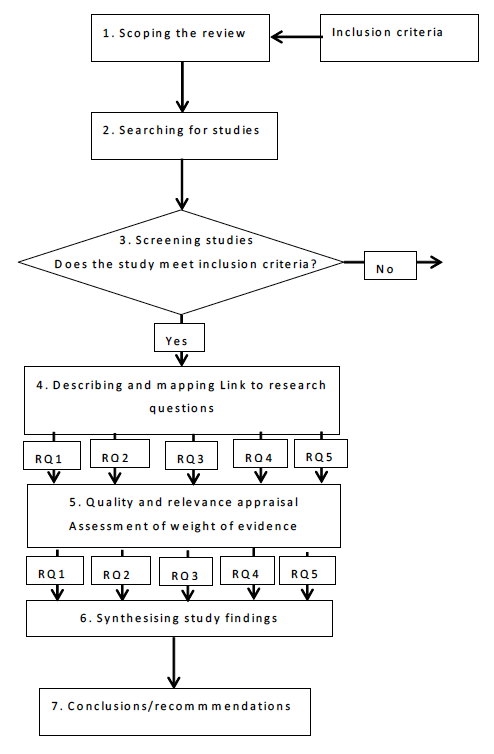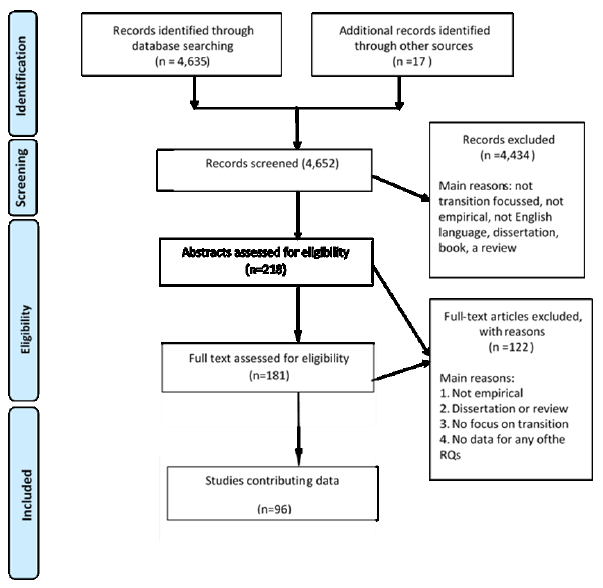Primary to secondary school transitions: systematic literature review
Impact of transitions and the factors that support or hinder a successful transition from primary to secondary school.
1. Introduction and Methodology
The University of Dundee has been commissioned by the Scottish Government to undertake this literature review to provide insight into the impact of transitions and the factors that support or hinder a successful transition from primary to secondary school.
The transition from primary to secondary school is viewed as a crucial and significant period in much of the existing literature[1], and has received more focus than any other educational transition[2]. However, Topping[3] noted that despite primary-secondary transition being so important, it was a neglected area of educational research in general. Several studies over the years have identified that there is a 'dip' in attainment at the time of primary-secondary transitions with a lack of expected progress and sometimes regression, especially in literacy and numeracy[4]. Various reasons have been given for this dip in academic attainment such as lack of curricular continuity between schools, differences in pedagogical approaches, differences in expectations of teachers in the two contexts, alongside lowering of self-esteem and mismatch between stage-environment fit[5] [6]. Alexander reported that this dip in attainment persists across education systems based on data from various countries, namely Germany, Ireland, Italy, Scotland, Spain, Tasmania and England[7].
The specific research questions addressed in this systematic literature review are:
1. What does the evidence from the UK and other countries suggest about the impact of the primary to secondary transition on educational outcomes and wellbeing?
2. What does the research suggest about the experiences of children and young people during their transition from primary to secondary?
3. What are the key factors that make a positive or negative contribution to the primary-secondary transition?
4. What does the evidence suggest about the differential impact of transition on children facing additional educational barriers such as poverty or additional support needs?
5. What does international evidence suggest about the characteristics of educational systems that support or hinder the transitional experience?
1.1 Methodology
We used the Evidence for Policy and Practice Information and Co-ordinating Centre (EPPI-Centre, 2010) approach to systematic literature reviews (see Figure 1).
1. Scoping the review: We started by developing explicit inclusion and exclusion criteria for specifying which literature to include in the review. This included relevance, recency, transparency and reliability/validity (see Table 1).
2. Searching for studies: We searched multiple online databases and our search returned 4,635 records for screening: (2,444 from three core databases in the Web of Science (WoS) - Science Citation Index Expanded, Social Sciences Citation Index, Arts & Humanities Citation Index; 679 from the Education Resources Information Centre (ERIC); 662 from the British Education Index (BEI); 569 from PsycINFO; and 281 from Applied Social Sciences Index and Abstracts (ASSIA). We also found a further 17 records through searching of other sources. [8]This gave a total of 4,652 records for screening (see Figure 2). We also scanned the contents of key journals in the field such as the British Educational Research Journal, and the American Educational Research Journal. We contacted key and eminent researchers in the field. Given the large volume of published studies that we found, we did not search for "grey" unpublished literature.
3. Screening studies: Each piece of literature was screened against the inclusion criteria developed when scoping the review (see Table 1 for criteria). By appraising each study against the same criteria and recording the results, the basis for the review's conclusions have been made transparent. Our screening process, which initially comprised reading of abstracts by one team member was conducted in accordance with our inclusion and exclusion criteria and resulted in 4,434 records being excluded for one of five main reasons: it was not a study that was focussed on transition between primary and secondary school; it did not report any empirical data; it was not published in full in the English language; it was a book or dissertation; or it was a report of a review, overview or discussion piece. This left 218 papers and their abstracts were reviewed by three other team members; resulting in rejection of 37 papers for the same reasons as above. A full read of all 181 papers led to further rejection due to the lack of meaningful fit with the research questions. This then left us with 96 studies which have been reported here (see Figure 2).
4. Describing and mapping: We described each included study using a standard keywording (coding) strategy such as the EPPI-Centre Education keywording strategy (EPPI-Centre, 2010), and included variables such as population focus, study design and key characteristics related to the research questions (see Appendix 1 for an example). These were used to draw up a 'descriptive map' providing a systematic description of research activity.
5. Quality and relevance appraisal: EPPI-Centre weight of evidence (WoE) judgments were applied to each of the included studies. Three components were assessed in order to help derive an overall weighting of evidence score (see Table 2):
a. Methodological quality: the trustworthiness of the results judged by the quality of the study within the accepted norms for undertaking the particular type of research design used in the study. This involved asking questions related to a study's reporting, context, sample, design, reliability and validity of data-collection and analysis (including appropriate number and range of explanatory variables in the statistical models), ethics, sample size, risk of bias resulting from selection and maintenance of sample, and generalisability.
b. Methodological relevance: the appropriateness of the study design for addressing their particular research question/s
c.Topic relevance: the appropriateness of focus of the research for inclusion answering the review question
The following scoring system was used to make assessments for each of the three components assesed: 1 = excellent, 2 = good, 3 = satisfactory, 4 = inadequate.
d.Judgement of overall weight of evidence (WoE) was made based on the assessments for each of the above criteria and by using the same scoring system. Studies classified as medium overall were still included in the synthesis as they met the inclusion criteria for the review, but less reliance was placed on their results. Studies were also graded as: A (directly relevant, UK based); B (probably relevant, non UK based but would equally likely apply to UK settings); C (possibly relevant, non UK but should be interpreted with caution due to strong cultural or institutional differences); D (not relevant, clearly irrelevant due to legislative differences). UK-based studies graded as A were further scrutinised to ascertain their direct relevance (i.e. in terms of context and characteristics of target population). Further details can be requested from main author.
6. Synthesising study findings: We used the approach of Narrative Empirical Synthesis (EPPI-Centre, 2010) to bring together the results of the mapping exercise. This mapping provides an accessible combination of results from individual studies in structured narrative summary tables.
7. Conclusions/recommendations: We then drew a set of recommendations closely linked to the findings of the synthesis so it is clear the basis on which each recommendation is made. In reporting specific data from studies, we have identified potential limitations of the reviewed studies and proposed a robust design for a Scottish study.
Figure 1: Based on steps of EPPI-Centre Systematic Literature Review

Table 1: Criteria for Inclusion
| Aspect | Criteria |
|---|---|
| Relevance | Relates directly to the Scottish Government research questions |
| Search Terms | 1. Transition*, 2. Transfer, 3. Mov* in combination with i. primary school, ii. elementary school, iii. middle school in combination with a. secondary school b. high school c. post-primary (all papers found through these searches were additionally hand searched for disabilit*, additional support need, support need, autism, inclus*, poverty*, etc.; and for a range of educational outcomes, factors, etc.) |
| Recency | Between 2008 and 2018 to cover the last ten years |
| Age-range | 10-14 (to cover UK and international educational systems) |
| Geographical spread | International, with the country and educational context clearly stated, with focus on the UK |
| Research base | Empirical research (either qualitative, quantitative or mixed methods) |
| Transparency | Methodology of the research should be explicit (e.g. sample size, instruments, analysis) |
| Reliability/validity | As far as can be determined, the findings upon which the study is based must be valid and reliable, taking into account the type of study, such degree of synthesis and interpretation versus descriptive for qualitative research, mitigating bias |
Figure 2: PRISMA flow diagram of study selection

Table 2: Criteria for judging 'weight of evidence'
| Level/criterion | Methodological quality | Methodological relevance | Topic relevance |
|---|---|---|---|
| 1: Excellent | Excellent research design with clear justification of all decisions: e.g. sample, instruments, analysis. Clear evidence of measures taken to maximise internal and external validity and reliability and reduce sources of bias. | Research questions (RQ) clearly stated. Methodology is highly relevant to their RQs and answers them in detail. | Study is very closely aligned to one of the key review objectives and provides very strong evidence upon which to base future policy/action. |
| 2: Good | Research design clearly stated with evidence of sensible decisions taken to provide valid and reliable findings. | RQs are explicit or can be deduced from text. Findings address RQs. | Study is broadly in line with one of the key review objectives and provides useful evidence. |
| 3: Satisfactory | Research design may be implicit but appears sensible and likely to yield useful data. | RQs implicit but appear to be broadly matched by research design and findings. | At least part of the study findings is relevant to one of the key review objectives. |
| 4: Inadequate | Research design not stated or contains flaws. | RQs not stated or not matched by design. | Study does not address any key research objective. |
1.2 Ethics
The team followed our profession's code of practice (General Teaching Council for Scotland, Health and Care Professions Council) and were governed by the University of Dundee Research Ethics Committee protocols (see https://www.dundee.ac.uk/research/governance-policy/ethicsprocedures/ethics/). The team are committed to ethical analysis of the literature and reporting.
1.3 Potential limitations
Although we used systematic literature review and there was cross-checking by team members at all stages, it is possible that we have missed some crucial literature in the search or rejected it based on our (collective) qualitative judgements. Also, we had a larger number of papers than expected; in some cases because we included papers that would normally not have been included by us due to lower Weight of Evidence. However, as they provided some valuable information to respond to the research questions set by the Scottish Government we opted to include this literature.
There is a problem
Thanks for your feedback